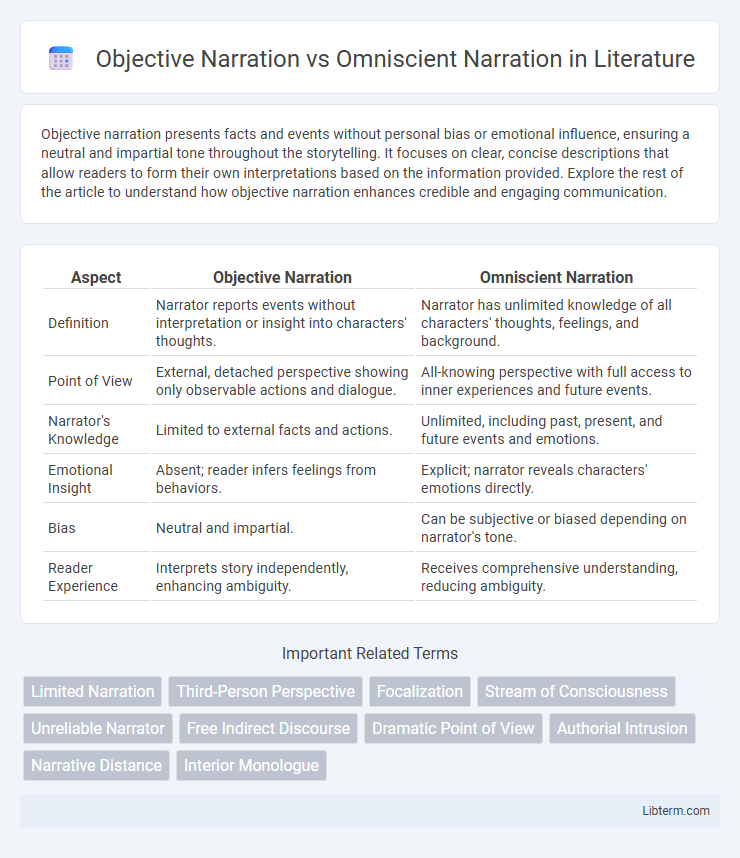Objective narration presents facts and events without personal bias or emotional influence, ensuring a neutral and impartial tone throughout the storytelling. It focuses on clear, concise descriptions that allow readers to form their own interpretations based on the information provided. Explore the rest of the article to understand how objective narration enhances credible and engaging communication.
Table of Comparison
| Aspect | Objective Narration | Omniscient Narration |
|---|---|---|
| Definition | Narrator reports events without interpretation or insight into characters' thoughts. | Narrator has unlimited knowledge of all characters' thoughts, feelings, and background. |
| Point of View | External, detached perspective showing only observable actions and dialogue. | All-knowing perspective with full access to inner experiences and future events. |
| Narrator's Knowledge | Limited to external facts and actions. | Unlimited, including past, present, and future events and emotions. |
| Emotional Insight | Absent; reader infers feelings from behaviors. | Explicit; narrator reveals characters' emotions directly. |
| Bias | Neutral and impartial. | Can be subjective or biased depending on narrator's tone. |
| Reader Experience | Interprets story independently, enhancing ambiguity. | Receives comprehensive understanding, reducing ambiguity. |
Understanding Narrative Perspectives
Objective narration presents the story through observable actions and dialogue without revealing characters' inner thoughts, offering a neutral and impartial perspective. Omniscient narration provides a comprehensive view by accessing multiple characters' thoughts, emotions, and backstories, creating a deeper, all-knowing narrative experience. Understanding these narrative perspectives enhances the analysis of storytelling techniques, character development, and reader engagement in literature.
Defining Objective Narration
Objective narration presents the story through observable actions and dialogue without revealing characters' inner thoughts or emotions, relying solely on external details. This narrative style emphasizes a detached, unbiased perspective, allowing readers to interpret the characters' motivations independently. Unlike omniscient narration, which provides insight into multiple characters' thoughts and feelings, objective narration maintains a strict boundary between narrator knowledge and character interiority.
What is Omniscient Narration?
Omniscient narration is a storytelling technique where the narrator possesses an all-knowing perspective, revealing the thoughts, feelings, and motivations of multiple characters within the narrative. This narrative style allows the reader to gain a comprehensive understanding of the plot and character dynamics by providing insights beyond any single character's viewpoint. Unlike objective narration, which presents only observable actions and dialogue without inner thoughts, omniscient narration offers a deeper, more intricate exploration of the story's emotional and psychological layers.
Key Differences Between Objective and Omniscient Narration
Objective narration presents the story through observable actions and dialogue without revealing characters' inner thoughts or feelings, maintaining a neutral and unbiased perspective. Omniscient narration offers a comprehensive view of the narrative by accessing multiple characters' thoughts, emotions, and backgrounds, providing a deeper understanding of motivations and plot development. The key difference lies in the level of insight provided: objective narration limits information to external facts, while omniscient narration delivers an all-knowing, internal perspective.
Strengths of Objective Narration
Objective narration excels in presenting an unbiased, fact-based account of events by limiting the narrator's insight to observable actions and dialogue. This style enhances reader engagement through interpretive freedom, allowing individuals to draw their own conclusions without authorial influence. Its strength lies in fostering realism and immediacy, creating a seamless narrative flow that mirrors real-life perception.
Advantages of Omniscient Narration
Omniscient narration offers the advantage of providing insight into multiple characters' thoughts, emotions, and motivations, enriching the depth of the narrative. This narrative style enhances storytelling by allowing a panoramic view of the plot and setting, creating a comprehensive understanding of the story's context. Readers benefit from the ability to perceive events from varied perspectives, which adds complexity and emotional resonance to the narrative.
Common Uses in Literature
Objective narration, often found in modernist and minimalist literature, presents an impartial, external viewpoint without revealing characters' inner thoughts, allowing readers to interpret events independently. Omniscient narration, widely used in classic novels and epic tales, provides a comprehensive, all-knowing perspective that delves into multiple characters' thoughts and backstories, enriching plot complexity and emotional depth. Both styles serve distinct narrative purposes: objective narration emphasizes visual and factual details, while omniscient narration facilitates intricate storytelling and thematic exploration.
Impact on Reader Engagement
Objective narration limits the perspective to observable actions and dialogue, encouraging readers to interpret characters' emotions and motivations independently, which enhances critical thinking and personal connection. Omniscient narration offers comprehensive insight into multiple characters' thoughts and feelings, fostering deeper emotional engagement and a richer understanding of the narrative's complexity. The choice between these narration styles significantly influences reader immersion and empathy by shaping how much internal context is disclosed.
Examples from Famous Works
Objective narration presents events without revealing characters' inner thoughts, as seen in Ernest Hemingway's "Hills Like White Elephants," where the narrative stays neutral and detached. Omniscient narration, by contrast, offers insight into multiple characters' thoughts and feelings, exemplified by Leo Tolstoy's "War and Peace," which explores diverse perspectives throughout the epic. These narrative modes shape reader engagement by either limiting or expanding access to character psychology and plot development.
Choosing the Right Narrative Style
Choosing the right narrative style depends on the story's need for perspective and emotional depth. Objective narration offers a detached, unbiased view by presenting facts and actions without internal thoughts, ideal for creating suspense or letting readers interpret events independently. Omniscient narration provides comprehensive insight into multiple characters' thoughts and motivations, enabling deeper emotional connections and complex storytelling.
Objective Narration Infographic

 libterm.com
libterm.com